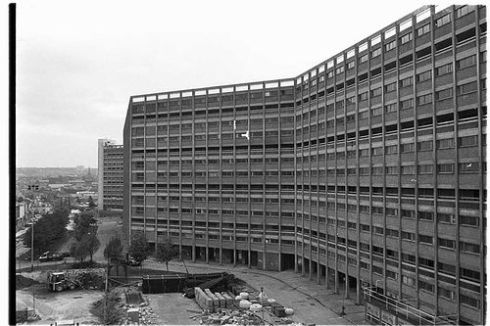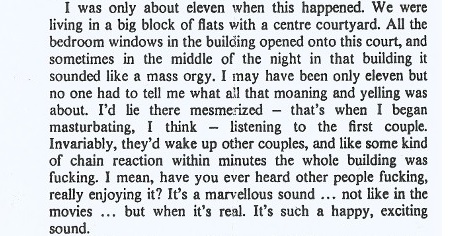Deep Fried In Kelvin (B-side to Lipgloss, 1993)
Deep Fried In Kelvin at Pulpwiki
“Many of Kelvin problems weren’t the flats, which inside were lovely, or the surroundings, which at the back were nicer still, or the facilities, which were aplenty… no, it was more a feeling of not being in charge, of not being King of your own castle. This had more to do with lack of available paid work, and the stigma attached to living on the estate, which was caused by the press demonising the place and by Kelvin being the first port of call for people with problems or a criminal history.
New doors or not, most of the people behind them were the most down to earth, trustworthy and friendly people you would ever be likely to meet. I’ve lived on five other estates since I left, and I have never found the same strong sense of community that Kelvin flats had.” – Peter Jones, Streets In The Sky, Life in Sheffield’s High Rise
“…claustrophobic walk-ups or corridors were rejected in favour of 12ft wide ‘streets in the sky’. These ‘streets’ were almost all connected with the ground, on steeply sloping land. Street corners were included where the winding building twisted around, with the spaces around the blocks filled with shops, schools and playgrounds…. …Park Hill is a battered remnant of a very different country, one which briefly turned housing for ordinary people into futuristic monuments rather than shamefaced little hutches. The ideologies of Regeneration and Heritage, when applied to the very different ethical aesthetic of the old New Brutalism, can only destroy the thing they claim to love.” – Owen Hatherley, ‘Penthouse and Pavement’
“Sheffield’s full of half-assed visions of cities of the future that turn into a pile of rubbish,” Russell Senior reflects, standing on the biggest traffic roundabout in Europe. “We grew up reading the local paper and seeing ‘Sheffield, city of the future,’ with a map of how it’s going to be and pictures of everyone walking around in spacesuits, smiling. But we’re the only ones who took it seriously…” – Russell Senior in the NME, June 1992
When I was young I felt sorry for people who lived in flats. My friends, family, the people on TV, they all lived in houses, proper ones with gardens at the back and front. The irony was that I lived in a flat myself, though the fact that it was part of a Victorian mansion rather than a 1960s concrete structure somehow meant that it didn’t count, at least in my mind. It wasn’t until I was an adult that I saw the real thing – in Southampton they were a looming presence, and my pizza-delivering housemates began avoid them whenever possible after having air-rifles fired as they rode past. This just confirmed my existing prejudice, that they were ugly and anti-human, vast battery cages for the unfortunate portion of humanity that were unable to live elsewhere.
Now I live in a gigantic complex in China with another 20,000 or so people and the difference is total. Everyone here seems to love flats – houses (especially brick ones) are for poor people, lack decent sanitation or heating, are infested with insects that can’t make it to higher levels. Even if you have a “villa” security becomes an issue – you can bar your windows but you’re still down there with the rabble, and there’s no security guard to stop them getting in.
I mention all of this not because I like to go on about myself (though that’s also undoubtedly the case) but to pull focus on the British view, that a man’s home is his castle, that our houses are the basic outlet for our self-worth and creative expression, a “truth” whose foundations may be shakier than we might like to think. For all we might believe concrete blocks to destroy culture and society by treating people as cogs in a huge machine, rows of identical Barrett houses are no more individual inside or outside, and the hidden hand of class conformity may make them actually more regimented than council tower blocks. To quote Peter Jones in the book linked above, “to you it was home: ugly from the outside, but beautiful, warm, cosy and safe on the inside.”
As with many political issues, then, this one may be inescapably entangled with emotions rather than expressible in logical terms. It comes down to what sort of life we want for ourselves and others, and what harder thing is there to discuss dispassionately? Deep Fried In Kelvin is saturated in emotional responses. Jarvis evidently feels that there is something fundamentally wrong with this place, and spends the song going through different ways to express this feeling. The environment is ugly and unfriendly, the people who live there are desperate, or have undergone some kind of environment-related moral degradation. No matter what good intentions the misguided might have towards them, they’re the ones mugging you at knifepoint late at night. If it wasn’t all expressed in such poetic, literary terms it could come straight from the pages of the Daily Mail.
At the start of the ‘The Full Monty’ a clip from the 1971 promotional film “Sheffield: City On The Move” is shown, and the full version can be seen on youtube here. As with many industrial cities in the UK, Sheffield’s city centre was gutted by bombs during the blitz and the opportunity was taken to rip out low-quality slum housing and replace it with huge concrete structures. The first of these was Park Hill, previously mentioned in Sheffield: Sex City, a great brutalist wave of concrete and brick connected by wide decks / bridges which connected the blocks together and which were supposed to be “streets in the sky.” and which was soon followed by similar developments – Hyde Park and Kelvin. In the film only the first two are mentioned, and only to boast of their size. Even in 1971 the buildings were clearly losing their lustre, as might be expected for any kind of council housing, and the film-makers clearly didn’t share the same vision for the future as the architects of these places. I hope anyone can agree that Kelvin was better than slum housing, but beyond that there seems to be little consensus on whether it was a good idea or not, whether it made communities or broke them and whether it gave people hope for the future or destroyed it.
For the man in the newspaper clipping placed in the middle of our series of vignettes, his need for a garden is such that he’s willing to destroy his flat, and the one beneath, for it. Is he a sad product of a failed system driven to his wits’ end, or does his need for a garden equate to a human need for a connection to nature, a connection not provided on concrete streets in the sky? The repetition of the last line would seem to answer this question. If a few find that concept naïve or troubling, others may be more concerned with the portrayal here of a criminal underclass, clearly beyond all redemption. The usual route for a piece of writing like this (I can’t think of a similar song) is to find a root cause, but there’s no easy way out here, just one great downward spiral of a sick environment, rotten conditions and people you want to avoid. This text is the product of an occasional visitor, one who’s been attacked by these kids and clearly feels no love for them, but who still can’t bring himself to look away – he’s not disgusted as such, but has the bitterness only the truly disillusioned (and therefore former true believers) can feel. It’s an apocalyptic vision of a song, and the seriously intoned monologue can’t entirely obscure the hellfire preacher tone – the song actually begins as a parody of a religious text, and culminates in a darkly humourous parody of Luke 18:16. It’s ridiculous, and that’s the point. Deep Fried in Kelvin is ultimately a work of satire, not a documentary.
I’ve left some fairly vital points behind in all this. Firstly, that the song is just short of ten minutes long, the longest thing the band ever put out, but justifies its length by never being dull for a moment. Second, there’s the music, an easy factor to forget in that it comprises nothing more than a barely changing band jam on a couple of chords. As band jams go, though, it’s not bad; Neu-meets-Bark-Psychosis, sonically interesting enough to imbue the words with extra drama, but low key enough to stay out of the way.
This isn’t quite the beginning of Pulp’s treatises on English class politics – it’s too much of a dark fantasy for that – but all the same, it’s a first step away from sensation and a first step towards issues. Next time we’ll see the group dive into this world, head-first.





